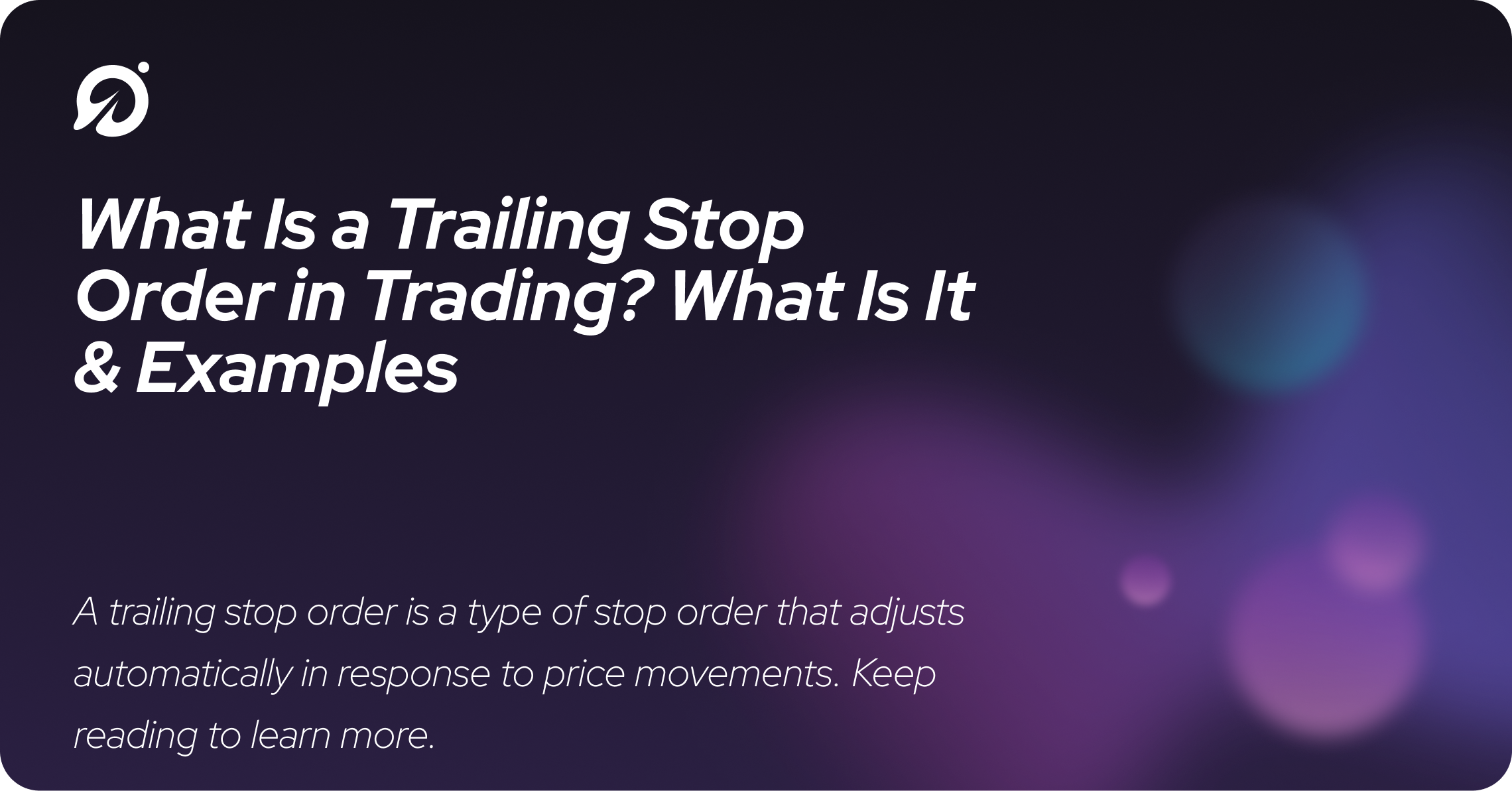What Is a Trailing Stop Order in Trading? What Is It & Examples
Understanding stop orders and trailing stop orders in trading can help you master your portfolio. Read on as Pluto gives you the lowdown.

Disclaimer: This is for informational purposes and is not meant to serve as financial or investing advice.
What Is a Stop Order?
In crypto trading, there are many order types. Knowing the types of orders and how to use them is part of every effective spot trading strategy.
A stop order is also known as a stop-loss order. A stop order allows the trader to set a price at which a trade executes automatically. Many investors use stop orders to limit losses (stop-loss) or to lock in potential profits.
For example, if you buy a token at $80 and your risk tolerance is a 10% loss, you would set a stop-loss at $72. If the price goes below $72, a market order is executed.
Whether you’re looking at crypto or stock prices, trading is known for its volatility. Instead of running a high-risk strategy, aiming for the highest price possible, trailing stop loss orders can help guard against loss and assure you don’t lose big on a failing asset or security’s price.
What Is a Trailing Stop Order?
A trailing stop order automatically readjusts the trigger price, where the order will execute in response to the price. In contrast, a regular stop order stays at a price you set until it’s executed or canceled.
Trailing stops get placed below the current market price in a long position. In a short position, trailing stops get placed above the current market price.
Like all stop orders, you don’t have to exit your position entirely when the order executes. You can set a trailing stop loss for 30 tokens to be sold and another lower trailing stop for 20 more tokens.
How Are They Used?
Trailing stop orders can dynamically limit your losses without selling too early.
Let’s say the earlier investment soars to $90, and you think it can go higher. If you set a trailing stop-loss for 10%, your stops would automatically be readjusted to the $81 level.
The advantage of the stop-loss is that you keep your upside open while being able to lock in profits if the price goes back down.
Regular stop orders are static numbers that don’t change. You can set them to limit losses or as your take profit number. They are valuable tools for a disciplined trading system as they prevent you from getting greedy and keeping trades open.
How Does a Trailing Stop Order Work?
Trigger Price
The trigger price is the price at which the stop order becomes a market order ready for execution on the order book. It’s important to understand that the trigger price simply converts it to a live order; it’s not the price that it will be filled at.
If you place a stop-loss at $100 and the price dips below, the order could execute at $99, $98, or anything below $100. The execution price is the market price once the order becomes active.
Trailing Amount
The trailing amount is the gap between the market price and your stop order. It’s usually a fixed percentage, but it can also be a dollar amount.
As the market price moves in favor of the trade, the stop-loss price moves with it. If the market price moves against the trade, the stop price does not change.
What Are the Benefits of a Trailing Stop Order?
Trailing Stops for Profits
Trailing stops losses and is significant for protecting profits. If the trailing stop price passes the entry price, the trade is guaranteed to at least break even. Barring a flash crash, of course.
This is especially useful for taking the emotion out of trading. You are removing FOMO and greed factors from trading by trailing stops.
Trailing Stops for Limiting Losses
Trailing stops can limit your downside losses. A standard stop-loss can limit losses by a fixed percentage or dollar amount.
With trailing stops, you can use favorable price movement to reduce your downside further. The significant part about trailing stop orders is that once your trigger price passes your original buy order price, you have a meager chance of losing on the trade.
What Are the Drawbacks of a Trailing Stop Order?
We know that trailing stops can limit losses and protect profits. But what are some of the drawbacks?
Sudden, sharp price fluctuations can trigger your stops. In volatile markets, a tight trailing stop could get triggered and cause the trader to miss profits.
Tight trailing stops are great for fine-tuned trades, but the crypto markets fluctuate several percentage points in a brief period.
Situations like flash crashes and extreme candle wicks are common. The price flickers below your stop price momentarily and forces you prematurely out of a trade.
The tighter the trailing amount, the more susceptible the trade is to this pitfall. It's a frustrating balance that many beginner traders overlook. How can you use trailing stop losses effectively without them constantly being triggered?
Well, there’s no free lunch in trading. But as you use trailing stops more often, you get a feel for how tight the stop should be based on market conditions and the type of asset you’re trading.
It’s worth noting that trailing stop orders are not supported by some trading platforms. And even if they do, it’s not guaranteed that every altcoin supports the order type.
What Are Examples of a Trailing Stop Order?
Scenario A — Long Position
Say you buy Litecoin at $65 and set a trailing stop of 20%. Your stop-loss price is $52. The next day, Litecoin's price reaches $75. Your new stop-loss is set at $60. The price soon crashes down past $60, at which point your order becomes a market sell order and is executed at $59.60.
In this scenario, the trigger price increases, but you still booked about a 12% loss on the trade. However, you limited your losses to almost half if you set a non-trailing stop-loss at $52.
Scenario B — Short Position
In this scenario, the trader is shorting the token XYZ. They enter the short at $50 with a 10% trailing stop. The trigger price is $55.
Remember, this is a short position, so if the price increases, they are at risk of being stopped out. The price decreases to $45; their trigger price moves up to $49.5. Since their trade is in profit now, they decide to take 50% of the profit and let the rest ride.
For more information about profits, check out our guide on when to take crypto profits.
The Bottom Line
Trailing stop orders are essential order types used by traders who want to protect profits and minimize downside losses. Trailing stops are a great way to babysit your position automatically if you're not day trading. As the price rises, you know that your stops are automatically moving up with the market.
There are drawbacks to trailing stop orders. During especially volatile market conditions, your trigger prices might be tripped on accident and cause you to miss out on the trade you planned. But you can remedy this by placing more significant trailing amounts or monitoring your open trades more closely.
You can learn to trade any market condition or asset class using a combination of limit orders, market orders, and trailing stops.
They are the building blocks of more complex trading strategies. And if you’re thinking of wading into automated trading strategies or trading with bots, you must know these order types backward and forwards — check out our guide to limit sell orders in trading next for more information.
Sources:
Stop-Loss Order—Make Sure You Use It | Investopedia
What is a Trailing Stop? | Investopedia
Trailing Stop Loss: What It Is & How It Works | Seeking Alpha
